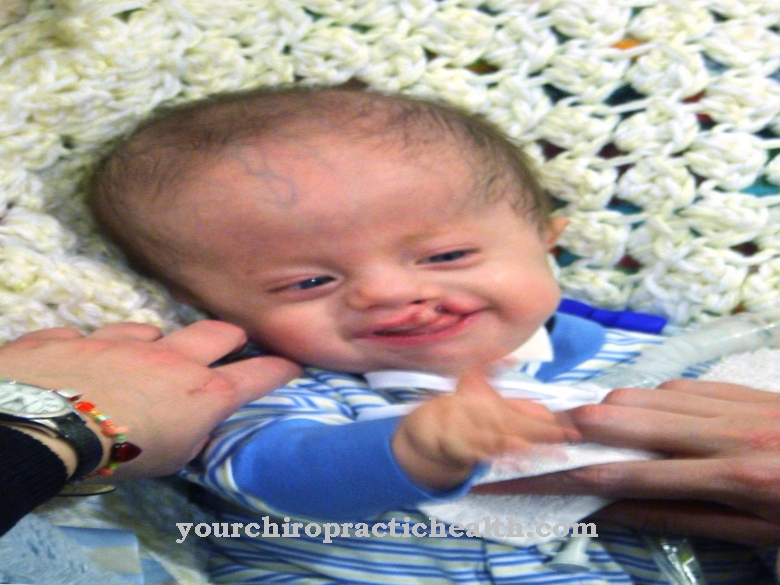As Hemiparesis is the incomplete paralysis of one half of the body. This is a symptom of a serious underlying disease and is triggered by damage to the opposite side of the brain. In the event of paralysis, a doctor must be consulted immediately.
What is hemiparesis?

Hemiparesis can affect people of all ages. The causes are varied and can lead to paralysis of the arms, legs or muscles in the face, tongue and mouth.
Hemiparesis is always caused by damage to the brain. If the left half of the brain is affected by a disease, the paralysis occurs in the right half of the body. If, on the other hand, the right hemisphere is damaged, the muscles in the left hemisphere are paralyzed. The more severe and persistent the disorder and the larger the affected brain area, the more pronounced the symptoms.
Movement disorders, the development of spasticity, decreased sensitivity to touch and pain or, in the worst case, serious mental disorders can be the result of hemiparesis.
causes
The most common cause of hemiparesis is a lack of oxygen in the brain. This can be triggered by a circulatory disorder in the blood vessels or a bleeding into the brain.
If the cerebral cortex is damaged as a result, the impulses responsible for movement are no longer transmitted from the brain via the spinal cord to the nerves without interference. Stroke not only occurs in advanced adulthood, it can also affect children. In addition to paralysis on one side, visual and speech disorders as well as dizziness and sometimes severe headache can be observed.
Other causes of hemiparesis can be brain injuries caused by accidents, inflammatory diseases such as meningitis or encephalitis or, less commonly, tumors in the brain. Here the paralysis does not occur suddenly, but develops over hours, days or even weeks.
Symptoms, ailments & signs
Hemiparesis manifests itself primarily through restricted movement of the left or right side of the body. The muscle tension on the paretic (paralyzed) side is either too weak or too strong. As a result, the person affected can no longer move as usual. Its movements are either uncoordinated or excessive.
It is often possible to stand or walk despite paresis (incomplete paralysis) while the affected arm can hardly be used. Despite the possibility of getting up and moving on their own or with help, many hemiplegics have problems with their balance or coordination. Hemiparesis or hemiplegia usually affects the facial muscles, so that the person affected can drip saliva from the corner of their mouth without them noticing.
Even when smiling, the corners of the mouth cannot be raised symmetrically. So it is not surprising that speech disorders can occur. Unfortunately, some patients experience double vision because the muscles that move the affected eyeball are partially paralyzed. Occasionally there are sensory disorders.
Surfaces, temperatures or objects are perceived imprecisely. It can happen, for example, that the person concerned does not feel when hot soup is pouring over his hand. The burn blisters that occur cannot be explained later.
Diagnosis & course
Since hemiparesis is only a symptom and not an independent disease, the cause must first be determined in order to be able to initiate successful therapy.
The neurologist can draw conclusions about the underlying disease on the basis of the respective medical history and the temporal occurrence of the paralysis (suddenly with strokes and cerebral hemorrhage, insidious with inflammation and tumors). A neurological examination checks the cranial nerves, reflexes, sensitivity to touch and strength in arms and legs.
In addition, the carotid artery is examined and the tension in the neck is assessed. In order to make pathological changes in the brain visible, the neurologist uses imaging methods such as computed tomography, magnetic resonance imaging (MRI) or angiography to clarify the hemiparesis.
Complications
Various complications can arise with hemiparesis. One-sided paralysis can initially lead to emaciation and frailty, often accompanied by severe motor disorders of the entire body. The internal and external organs can also be affected and damaged in various ways as the disease progresses.
In mild cases, the paralysis reduces the sense of balance and mobility is impaired. In severe cases, pneumonia and thrombosis in the paralyzed limbs and impairment of the excretory organs occur, also with a number of other complications. In addition, intellectual performance can decrease in the context of hemiparesis.
Depending on the severity of the paralysis, inflammation of the joints is also possible. Further complications arise from being bedridden: ulcers (pressure ulcers), urinary tract infections and contractures, joint stiffness, muscle wasting and epilepsy occur. Hemiparesis can also lead to blood clots and severe pain in the affected parts of the body due to the paralysis that occurs and the associated circulatory disorders.
This can lead to a stroke or the spread of the disease. Whether and to what extent these secondary symptoms occur depends on the severity of the hemiparesis and the treatment of the underlying disease. Early treatment can usually prevent serious complications.
When should you go to the doctor?
If you have hemiparesis, you should see a doctor immediately. In the worst case, the paralysis can remain permanent and then no longer be treated. An early diagnosis always has a positive effect on the further course of the disease. In the case of hemiparesis, the doctor should be consulted if severe paralysis occurs suddenly and for no particular reason. In most cases, facial paralysis also occurs.
Those affected also suffer from disorders of movement and coordination and, as a result, from significant restrictions in their everyday life. Visual disturbances or speech disorders also indicate the disease and should always be examined by a doctor if they occur suddenly and do not go away on their own. This can prevent these disturbances from occurring permanently.
The examination and treatment can be done by a neurologist. In acute emergencies or in the event of severe complaints, the hospital can also be visited. Further treatment usually depends on the exact cause of the hemiparesis and the patient's options.
Doctors & therapists in your area
Treatment & Therapy
The therapy of hemiparesis is primarily aimed at giving the patient back and maintaining his independence through various exercises. The treatment depends crucially on the underlying disease.
If a stroke is the cause of the symptoms of paralysis, the patient is immediately given coagulants to dissolve the blood. Bleeding usually requires surgery to prevent it from spreading to the surrounding tissue. Hemiparesis caused by meningitis or encephalitis is treated with antibiotics or antivirals.
A tumor can possibly be surgically removed. Chemotherapy and / or radiation therapy may also be necessary. After the acute treatment, the patient usually receives a rehabilitation program consisting of physiotherapy, occupational therapy and speech therapy in a second step. The use of orthotics is ideal to combat paralysis in the extremities. Treatments with botulinum toxin or operations are also promising.
Another approach is forced use therapy, in which the healthy limbs are fixed in order to move the patient to use the paralyzed extremities. Hemiparesis is often accompanied by strong feelings of fear. Psychotherapy is therefore recommended.
Outlook & forecast
A distinction must be made between people who already suffered from hemiparesis at birth and people who develop the disease as a result of a stroke. The first group has no chance of recovery. Although therapies show how to cope with everyday life, help remains necessary for a lifetime.
The second group can improve, but this depends on certain conditions. One-sided paralysis after a stroke leads to differentiated chances of recovery. Basically, the likelihood of recovery increases when patients are still quite young and the degree of severity is low. Movement disorders can be minimized with individual therapy.
Nerve areas can then transform themselves. However, the effort is great. Regression can take months or years. Other people can improve their feelings, but they remain dependent on help for life.
Sick people can take steps themselves to improve their prognosis. It has been scientifically proven that alcohol and cigarettes are not cure. Instead, patients should eat a healthy and balanced diet. Any excess weight is to be reduced. Movement should be done within the limits of what is possible.
prevention
Since a hemiparesis is triggered in most cases by a stroke, risk factors such as high blood pressure or calcification of the vessels must be combated. A healthy lifestyle with a balanced diet and sufficient exercise prevents obesity and makes a decisive contribution to maintaining health. If the blood vessels are already constricted by deposits or if there are cerebral circulatory disorders, the administration of medication is a must.
Aftercare
Different follow-up measures are necessary depending on the cause of the hemiparesis. If the hemiparesis is based on a tumor, chemotherapy or radiation therapy is often carried out as part of the follow-up care. If the one-sided paralysis was triggered by a blood clot (thrombosis), doctors prescribe medication to thin the blood. These have a preventive effect and prevent the formation of further thromboses.
To restore the greatest possible mobility of the paralyzed muscles, physiotherapy is an integral part of effective aftercare. Through special movement exercises, the patient should be given back a high degree of independence. The earlier and more intensely physiotherapy begins, the more effectively the paralyzed areas can be restored. However, a full recovery is rarely possible.
If the hemiparesis has also affected the facial muscles, speech therapy is also part of the follow-up care. The aim is to increase speech intelligibility. If spasms persist despite physiotherapy or speech therapy, Botox is sometimes used to loosen up the muscles. This relieves convulsive attacks.
After hemiparesis, the patient often has to prove his fitness to drive in the course of an assessment, as the hemiparesis can lead to failure symptoms. Since hemiparesis is associated not only with physical limitations but also with high psychological stress, accompanying psychotherapy is often carried out.
You can do that yourself
Direct self-help or possibilities for self-treatment are usually not possible with hemiparesis. The disease can only be partially prevented by leading a healthy lifestyle. This includes a healthy diet and sufficient physical activity. Above all, being overweight should be avoided in order not to trigger hemiparesis.
Since those affected by this disease suffer from severe paralysis and thus from limitations in their lives, they are dependent on the help of family and friends. Loving and patient care has a very positive effect on the course of the disease and can possibly also alleviate or prevent psychological complaints.
In many cases it is also worth contacting other sufferers or a psychologist to talk about the possible course of the disease. In doing so, possible feelings of fear can also be resolved. Especially with children, detailed discussions about the consequences of hemiparesis are necessary.
Since the patient's sense of balance is also negatively affected by the disease, they should use walking aids to avoid further injuries. In the event of an epileptic fit, an emergency doctor must be notified immediately. The person concerned should be brought into a stable lateral position and reassured until they enter.













.jpg)

.jpg)
.jpg)











.jpg)